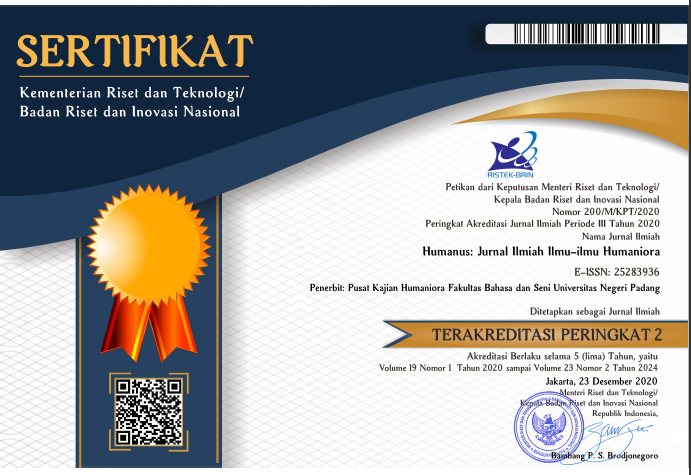Musical Instrument ‘Talempong Minangkabau’ in Organological Study
 ), Bambang Parmadi(2),
), Bambang Parmadi(2), (1) (SINTA ID : 6028626) FBS Universitas Negeri Padang
(2) Universitas Bengkulu
 Corresponding Author
Corresponding Author
Copyright (c) 2022 Humanus
Full Text:
 Language : en
Language : en
Abstract
This study aims to photograph the traditional process of making Minangkabau talempong from start to finish. Descriptive analysis methods are used in this qualitative study. The process of making is systematical, factual, accurate, and originally analyzed by thought in the light of library reviews, and journals. In the process of making it, black clay is mixed with chaff and milled red clay. The principal ingridients were brass or copper (Cu), tin (Sn), and iron (Fe). The process begins with the production of a wax talempong model, binding the wax talempong with a clay mixture to make a cast of talempong ground, and casting off its then casting, the matter is burned to extract the wax and is in a row sent out by interlaced. Eventually, the prints were destroyed and talempong produced. After cleaning, leveling, grinding, milling, and polished, talempong is ready. There are three varieties of talempong in size: (1) large; (2) moderate; and (3) small. The talempong is traditionally displayed by striking the outside to match the tone or striking the outside to match the tone.
Keywords
References
Alfalah. (2013). Perkembangan Talempong Tradisi Minangkabau Ke “Talempong Goyang” Di Sumatera Barat. Jurnal EKSPRESI SENI, Vol. 15, No. 1. Juni 2013 hal. 1-11. Padangpanjang: Visigraf Padang.
Asril. (2018). Dilematika Pengembangan Musik Talempong Tradisi Menjadi Talempong Kreasi dan Talempong Goyang. Jurnal MELAYU ARTS AND PERFORMANCE JOURNAL, Vol. 1, No. 2, Oktober hal. 123-136. Padang panjang: Program Pasca Sarjana ISI Padangpanjang
Backus, J. (1997). The Acoustical Foundation of Music. New York. W.W Norton & Company Inc.
Bahar, M. (2009). Musik Perunggu Nusantara Perkembangan Budayanya di Minangkabau. Bandung: Sunan Ambu STSI Press.
Expósito, J. E. M., Galán, S. G., Reyes, N. R., Candeas, P. V. (2009). “Speech/Music Discrimination Based On Warping Transformation and Fuzzy Logic For Intelligent Audio Coding”. Applied Artificial Intelligence: An International Journal Taylor & Francis. On: 23 June, Page: 427–442. London: Copyright © 2009 Taylor & Francis Group, LLC.
Lampert, F. (2014). Bibliography in Music Appreciation. JSTOR Source: Music Supervisors' Journal, Vol. 6, No. 1 (Sep), pp. 20-30. Published by: Sage Publications, Inc and MENC: The National Association for Music Education.
Laneau, J., Wouters, J., Moonen, M. (2006). “Improved Music Perception with Explicit Pitch Coding in Cochlear Implants”. KARGER Journal Neurotology and Audiology. Received: October 14, 2004, Accepted after revision: June 29, 2005, Published online: October 10, 2005. Audiol Neurotol 2006;11: Page:38–52.
Mack, D. (2001). Pendidikan Musik Antara Harapan dan Realis. Bandung: UPI/MSPI.
Magnusson, T. (2011). Algorithms as Scores: Coding Live Music. LEONARDO MUSIC JOURNAL, Vol. 21, pp. 19–23.
Marsden, F.R.S. William. (2016). Sejarah Sumatra “The History of Sumatra”. Yogyakarta: Indoliterasi.
Merriam, A. P. (1980). The Anthropology of Music. Evanston Illinois: Northwestern University Press.
Miller, Hugh M. (2016). Music Appreciation “Introduction to Music: A Guide to Good Listenig”. Jakarta: Perpustakaan Nasional: Katalog Dalam Terbitan (KDT)
Miles, Haberman, and Saldana (2014). Qualitative Data Analysis A Methods Sourcebook. United State of America: SAGE Publications, Inc.
Muhammad. Takari. 1993. Klasifikasi Alat-Alat Musik. Etnomusikologi. USU. Medan.
Nakagawa, S. (2000). Musik dan Kosmos: Sebuah Pengantar Etnomusikologi. Jakarta: Yayasan Obor Indoniesia.
Panggiyo. (2015). Akustika Resonator Pada Gamelan. Keteg: Jurnal Pengetahuan, Pemikiran, dan Kajian Tentang Bunyi. Surakarta: Institut Seni Indonesia Surakarta.
Parmadi, B, B. (2021). Globalization Of Tourism Industry Toward Culture Of Local Wisdom In The Existance Of Pseudo Traditional Art Case Study of the Commodification of Bengkulu Traditional Arts. LEKESAN: Interdiciplinary Journal of Asia Pasific Arts Volume 4, Issue 2, October ISSN: 2598-2192 (Online)102 Peer, page: 102-109. Denpasar: ISI Denpasar.
Parmadi, B. (2021). Genealogi Sosiokultur Musikalitas Sonai Gan`dai Mukomuko Bengkulu. MUDRA Jurnal Seni Budaya Volume 36, Nomor 1. Denpasar: ISI Denpasar.
Sastra. A.I. (2015). “The group Concept of Building Raso Batalun in the Performnace of Talmepong renjeang Anam Salabuahan.” Jurnal Humaniora, Vol.27 No.1 Februari, hal. 42-52. Padang: FBS UNP Padang.
Sastra. A.I. (2016). Estetika talempong Renjeang. Padangpanjang: LPMPP ISI Padangpanjang.
Schmeling, P. (2005). Music theory. Boston USA: Berklee Press
Syeilendra. (2000). Musik tradisi. Padang: DIP UNP.
Suneki, S, (2012). “Dampak globalisasi terhadap eksistensi budaya Daerah”, Jurnal Ilmiah CIVIS, Vol. 2I No. 1, hal. 307-321. Semarang: FPIPSKR Universitas PGRI Semarang.
 Article Metrics
Article Metrics
 Abstract Views : 291 times
Abstract Views : 291 times
 PDF Downloaded : 87 times
PDF Downloaded : 87 times
Refbacks
- There are currently no refbacks.
Copyright (c) 2022 Humanus

This work is licensed under a Creative Commons Attribution-NonCommercial 4.0 International License.










